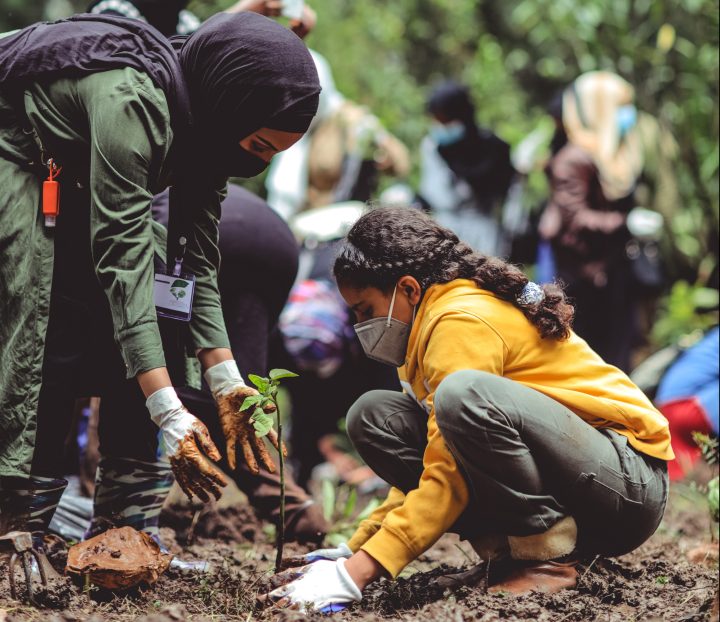
Food Justice
What we should teach our children about our (broken) food systems

Widespread hunger and food stability are not easy topics of conversation in light of the climate crisis. In fact, to broach them can be taxing and disheartening even for adults. So how should we be exposing our young ones to these issues?
According to this 2020 World Bank report, 55.5% of the South African population lives at or under the national poverty line, while 25% experiences food poverty. Couple that with the fact that 35.7% of the population is under 19 years of age, and many children are going hungry every day. It’s clear that hunger and food stability are pressing issues that our children live with daily, whether they are hungry themselves, or surrounded by evidence that too many of their peers are not getting enough of the right things to eat.
Further, as this 2020 study on youth and food system transformation points out, the youth are “entitled to expect decent work and livelihoods, as well as long and healthy lives; yet to achieve this objective for so many people will be challenging in an era of ecological stress. From a development perspective, today’s youth generation is on the front line: it will have to cope with the effects of environmental and climate change, which are likely to accelerate and intensify during their lifetimes.”
In other words, the youth of today are up against unprecedented ecological strife, and what we teach our children about food justice and food systems will have an enormous impact on the unfolding economic, social, and political developments over the coming decades. “Their lives will reflect humanity’s success or failure in moving toward more ecologically sustainable and socially equitable development,” said the study authors.
But this is a zoomed-out truth, so big-picture it is almost impossible to swallow at all. To bring us back to a more manageable scale, we should remember that everything starts small, and access to healthy food is key to a healthy community. How can we, in our various communities, best teach children about the importance of food justice and the unfortunate hunger that surrounds them, as well as the bleak environmental future that they will inevitably have to confront?
What should we be teaching?
According to René Pfaff, a practicing psychologist of 24 years with experience in the fields of education and children, the topics that we need to raise with our young ones include “sustainable farming and self-sufficiency, managing food wastage, and health and nutrition”. However, it is important to remember that these topics can be totally overwhelming and anxiety-inducing for young children if introduced too quickly or without care.
According to Pfaff, trying to teach children about sociological issues and hardships on a complex scale “can create huge anxiety and feelings of guilt and worry because they have no control over these issues at all”.
Rather, when we teach children about hunger and food justice, our lessons should be practical and solutions-based, as well as age appropriate. We should focus on small and productive projects that embody the central aspects and ethics that a more sustainable food system might have.
Successful projects of this type should also be relevant to the child’s surrounding community, focusing on issues that might affect the community in day-to-day reality. “Stable homes can focus more on sharing and creating access,” suggests Pfaff, “whereas children with less food stability should be taught ways to access food and communicate need.”
How should this teaching be done?
Pfaff advises that a combination of parental and institutional efforts to teach children about food justice would be the best approach. Parents can reinforce lessons learnt about food justice around the dinner table, or perhaps the whole family could volunteer at a garden or soup kitchen.
Schools should have a more structured and holistic method of teaching these important lessons. Pfaff suggests that food justice should be included in many parts of the curriculum, from history (how and why our food systems got to where they are) to life orientation (why it’s important to feed ourselves nourishing food and how that is connected to food systems).
Storytelling
A gentle (and sometimes even fun) way to introduce your children to the concept of widespread hunger is through story books. There is a lot of good children’s literature out there, and stories can offer an engaging and digestible approach.
Story books generally follow one or two main characters. By creating fleshed out and personalised characters with whom children might identify, books provide a potential space for cultivating empathy.
Get hands on with it
To Pfaff, first-hand experience is very productive in initiating conversations about food systems. One way to do this is to work in a community garden, whether it be a garden run by a school, a group of friends, or a neighborhood board.
While gardening, says Pfaff, children might learn basic urban, organic and sustainable farming practices. Taking part in the production and maintenance of food sources will teach kids the basics of nutrition coupled with the study of food origins and preparation.
Further, community gardening has been the object of much research for environmentalists and social scientists. This academic paper is an amalgamation of literature and research that found multiple aspects of community gardens to be beneficial to the people who work in them. For example, working in a garden can improve general health by increasing fruit and vegetable intake, fostering physical activity, reducing food insecurity (ie members of the garden can eat the produce that they grow), and improving mental health. Not to mention the fact that gardening is fun!
The same paper also found that in certain communities, gardening and growing food were great ways to keep tradition alive: “growing food, including culturally relevant foods, has helped some communities maintain cultural connection and continuity”.
Other ways of getting hands-on with your kids include volunteering at soup kitchens, attending organic cooking classes, or sandwich and soup drives.
Pfaff advises that schools and parents should look up local NGOs that are running food justice initiatives and pair up with them to create youth programmes.
To round it all up
Teaching our children about widespread hunger and food justice is imperative because they are very real issues in South Africa and around the world. With the global environmental situation as it stands, educating our children at a young age feels like a pressing necessity.
- Be gentle and empathetic: Talking about the present and future of our food systems must be done with care and thought. Specifically, children should be taught about these issues in practical and optimistic ways: our lessons need to be solutions based in order to avoid causing anxiety or feelings of guilt.
- Get a good story book: This can be done through well-written story books that approach the topic in a specific and personalised manner.
- Get hands on: Another fantastic option for teaching children about food systems is by getting them involved in hands-on projects, such as taking classes or volunteering in community gardens.
DM/ML/MC


















These are wonderful ideas but there is a major stumbling block. The cellphone and social media. The kids around me do not find gardening fun. Would they rather starve than spend time turning the sod, planting, watering and weeding? Parental control and discipline are gone. And I’m doubtful that the lost ground can ever be regained; a bridge too far. As avid gardeners who grows more than half our food in a suburban garden we find it very distressing.